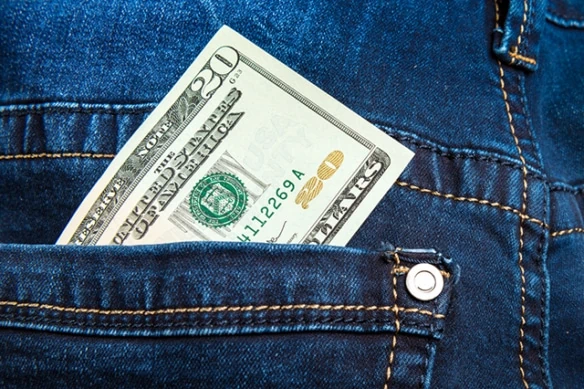The headline consumer price index (CPI) print for February came in as expected on Tuesday. However, both year-over-year inflation and the “core” gauge of consumer prices both came in a touch hotter than expected, more or less extinguishing any remaining thoughts of a spring rate cut from the Federal Reserve.

The U.S. Department of Labor said on Tuesday that February’s consumer price index, which measures the change in prices on a variety of consumer goods and services, was 0.4% higher from January on a seasonally adjusted basis, which was in line with expectations from Dow Jones-polled economists.
That said, inflation’s year-over-year change of 3.2% was slightly higher than both the previous month’s YoY reading and economists’ forecasts.
9 Monthly Dividend Stocks for Frequent, Regular Income
And “Core” CPI—a measurement that backs out food and energy costs, which are more volatile than the other costs tracked by the Labor Department—came in slightly higher than expected on both a month-over-month basis (+0.4%) and a YoY basis (+3.8%).
Here’s a quick look at Tuesday’s key figures:
- MoM CPI: +0.4% (vs. +0.4% est.)
- YoY CPI: +3.2% (vs. +3.1% est.)
- MoM Core CPI: +0.4% (vs. +0.3% est.)
- YoY Core CPI: +3.8% (vs. +3.7% est.)
Energy was the most noteworthy contributor to February’s rising prices; energy costs rose 2.3% MoM, including a 3.8% jump in gasoline prices. Airline fares were 3.6% higher in February, apparel prices were 0.6% higher, and used cars and trucks were 0.5% higher.
Continued expansion in services prices remained somewhat sticky but did cool, coming in 0.4% higher month-over-month.
“Services inflation experienced some moderate softening in February—a promising sign in the trajectory of inflation considering how strongly it printed in January,” says Gargi Chaudhuri, Head of iShares Investment Strategy, Americas. “Fed Chair Jerome Powell stated that he wants to have ‘greater confidence’ in the trajectory of inflation before instituting a rate cut. Since goods prices have already been deflationary, we think the remaining room for progress lies mainly in core services.”
Should I Pay Off My Mortgage Before I Retire?
Part of that cooldown in services came from shelter prices, which only grew 0.43% after climbing 0.63% in January. “Investors were worried that the BLS’s reweighting of shelter inflation to better reflect single-family units would skew the data higher, but this print told us that January’s surprise was due to volatility in prices and not issues in the methodology,” Chaudhuri says.
At this point, most experts have their eye on a late-spring or early summer start to any cuts to the federal funds rate.
“Last night, futures markets were pricing less than a 5% chance that the Fed did anything at their meeting next week, and this print all but cements no action occurring (less than 1% now),” says Josh Jamner, Investment Strategy Analyst at ClearBridge Investments. “Importantly, the Fed will have additional inflation data in hand by the time of their subsequent meetings that will be more important to their decision-making than today’s release, which on its own does not preclude nor confirm a rate cut from occurring around mid-year.”
More Pros’ Takes on February CPI
Here, we outline more thoughts from the experts on what February’s CPI numbers mean for consumers, markets, the Federal Reserve’s future actions, and more:
“The bad news is that core inflation came in just slightly above the expected level. The good news for the Fed and the markets is that shelter inflation was better behaved and the spike in food inflation last month was not repeated. … The Fed’s preferred inflation measure, core PCE inflation, will continue to be better behaved than its CPI cousin in February. This report means that a May rate cut has likely been removed from the Fed’s menu.
“I still see June as the most likely month for the first cut, but this could shift to July if the inflation data does not start to improve next month. … While I expect some upward shifts to the individual dots, I believe the median dot from the upcoming Fed projections will continue to indicate that we are on pace for 75 bps in rate cuts in 2024.”
—Greg Wilensky, Head of US Fixed Income, Janus Henderson Investors
“Airfares jumped 3.6% in February, the largest monthly rise in nearly two years (since May 2022). This outsized increase was likely the difference between the core CPI measure rounding to 0.3% for the month vs. 0.4%, given the actual number came in at 0.358%. Importantly, airfares are one of the categories that do not carry from CPI over to the Fed’s preferred core PCE measure, with PCE taking its airfare metric from Thursday’s PPI report. The so-called CPI-PCE wedge—with CPI running hotter than PCE—doesn’t seem likely to go away in the near future.”
—Josh Jamner, Investment Strategy Analyst, ClearBridge Investments
“Inflation came in a little hot but the bulls aren’t ready to throw in the towel yet. Investors remain optimistic that shelter costs will come down. We still have three more reports before that key Fed meeting in June to confirm or reverse that hope. Wall Street is keeping the faith for now but that could change if future prints don’t improve. Stocks are still climbing the wall of worry.”
—David Russell, Global Head of Market Strategy, TradeStation
“In his congressional hearing last week, Chair Powell did not provide a specific timeline on the timing of rate cuts, but he did tell Congress that we are likely at peak rates. The Fed’s careful tone in February’s FOMC meeting also confirmed our belief that the Fed will not decrease interest rates at their March meeting. Previously, Chair Powell frequently noted that the committee wants to see more data to confirm that inflation is on a path to sustained 2% YoY price growth. We believe three interest-rate cuts are plausible for 2024, but we don’t expect the first cut to arrive until June. Any more cuts would be because of a meaningful deceleration in the U.S. economy, which is not our base case.”
—Gargi Chaudhuri, Head of iShares Investment Strategy, Americas
“Like a piece of gum stubbornly stuck to the bottom of their shoes, sticky services inflation is a problem that the Fed just can’t shake. If sustained through 2024, two straight months of 0.4% gains on the Core CPI puts it on pace for almost 5% for the year, which is well above the Fed’s 2% target range. Today’s report likely doesn’t change the Fed’s calculus all too much, as it still seeks evidence of sustainably waning inflation before cutting rates. The base case remains roughly three rate cuts this year beginning sometime around summer.”
—Jason Pride, Chief of Investment Strategy & Research, Glenmede
“The current risks for investors are skewed toward a delay for the first Fed funds rate cut beyond June – which is what the market is currently pricing in. Chair Powell stressed the Fed’s focus on three main items of the CPI inflation that are food, transportation and housing inflation as having the most damaging effects on Americans’ wealth.”
—Morgane Delledonne, Global Head of Investment Strategy, Global X
Retired But Too Young for Medicare? Health Insurance for Early Retirees







